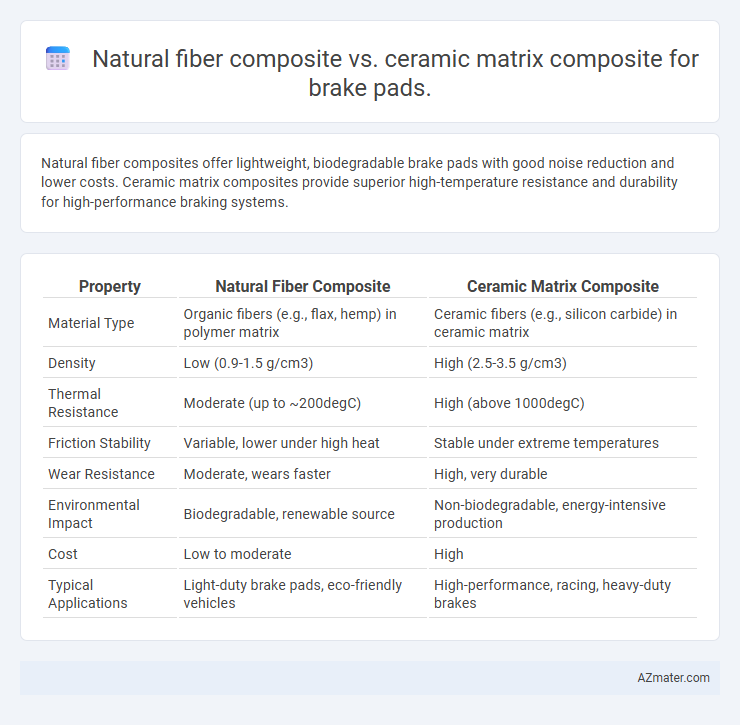Natural fiber composites offer lightweight, biodegradable brake pads with good noise reduction and lower costs. Ceramic matrix composites provide superior high-temperature resistance and durability for high-performance braking systems.
Table of Comparison
| Property | Natural Fiber Composite | Ceramic Matrix Composite |
|---|---|---|
| Material Type | Organic fibers (e.g., flax, hemp) in polymer matrix | Ceramic fibers (e.g., silicon carbide) in ceramic matrix |
| Density | Low (0.9-1.5 g/cm3) | High (2.5-3.5 g/cm3) |
| Thermal Resistance | Moderate (up to ~200degC) | High (above 1000degC) |
| Friction Stability | Variable, lower under high heat | Stable under extreme temperatures |
| Wear Resistance | Moderate, wears faster | High, very durable |
| Environmental Impact | Biodegradable, renewable source | Non-biodegradable, energy-intensive production |
| Cost | Low to moderate | High |
| Typical Applications | Light-duty brake pads, eco-friendly vehicles | High-performance, racing, heavy-duty brakes |
Introduction to Brake Pad Materials
Brake pad materials primarily consist of composites engineered to withstand high friction and temperature during braking. Natural fiber composites offer eco-friendly, lightweight alternatives with good wear resistance and noise reduction properties, making them suitable for passenger vehicles. Ceramic matrix composites provide superior thermal stability, high strength, and enhanced durability under extreme conditions, commonly used in high-performance and heavy-duty braking systems.
Overview of Natural Fiber Composites
Natural fiber composites for brake pads offer advantages such as biodegradability, low density, and renewable resources, making them environmentally sustainable alternatives to traditional materials. These composites combine natural fibers like hemp, flax, or jute with polymer matrices to provide adequate mechanical strength and improved damping properties for braking applications. They exhibit lower thermal resistance compared to ceramic matrix composites but compensate with reduced wear and cost-effective manufacturing processes.
Overview of Ceramic Matrix Composites
Ceramic matrix composites (CMCs) in brake pads offer exceptional thermal stability and resistance to high temperatures up to 1,600degC, surpassing natural fiber composites which generally degrade under extreme heat. CMCs consist of ceramic fibers embedded in a ceramic matrix, providing superior wear resistance and mechanical strength essential for high-performance braking systems in aerospace and sports cars. Their lightweight nature combined with excellent frictional properties ensures improved brake efficiency and longer service life compared to traditional organic or natural fiber-based composites.
Material Properties Comparison
Natural fiber composites offer lightweight properties, high specific strength, and good damping capacity, making them effective for reducing noise and vibration in brake pads. Ceramic matrix composites exhibit superior thermal stability, high hardness, and excellent wear resistance, which ensures enhanced performance under high-temperature braking conditions. Comparing both, natural fiber composites excel in eco-friendliness and cost efficiency, while ceramic matrix composites provide greater durability and long-term performance in demanding applications.
Performance in High-Temperature Environments
Natural fiber composites offer moderate performance in high-temperature brake pad applications due to their lower thermal stability and tendency to degrade above 200degC. Ceramic matrix composites demonstrate superior thermal resistance, maintaining structural integrity and friction stability at temperatures exceeding 600degC, essential for high-performance braking systems. The enhanced thermal conductivity and oxidation resistance of ceramic matrix composites make them ideal for prolonged exposure to extreme temperatures in automotive and aerospace sectors.
Environmental Impact and Sustainability
Natural fiber composites for brake pads significantly reduce environmental impact due to their biodegradability, lower carbon footprint, and renewable resource base compared to ceramic matrix composites. Ceramic matrix composites, while offering superior thermal resistance and durability, involve energy-intensive manufacturing processes and generate non-biodegradable waste that challenges sustainability goals. The shift towards natural fiber composites aligns with eco-friendly automotive trends by minimizing hazardous emissions and promoting end-of-life recyclability.
Cost and Manufacturing Considerations
Natural fiber composites for brake pads offer significant cost advantages due to lower raw material expenses and simpler manufacturing processes compared to ceramic matrix composites (CMCs). CMCs require high-temperature processing and specialized fabrication techniques, increasing production costs and limiting scalability. The ease of processing natural fibers with conventional molding methods enhances manufacturing efficiency and reduces overall brake pad costs.
Wear Resistance and Longevity
Natural fiber composites in brake pads offer moderate wear resistance and biodegradability but generally exhibit lower longevity compared to ceramic matrix composites, which provide superior wear resistance due to their high hardness and thermal stability. Ceramic matrix composites maintain structural integrity under extreme temperatures, significantly enhancing brake pad lifespan and reducing wear rate during aggressive braking conditions. The advanced microstructure of ceramic composites minimizes material degradation, making them a preferred choice for high-performance and heavy-duty brake applications.
Applications in Automotive Industries
Natural fiber composites offer lightweight, cost-effective solutions with excellent vibration damping and environmental benefits, making them suitable for standard brake pads in passenger vehicles focused on sustainability. Ceramic matrix composites provide superior high-temperature resistance, wear durability, and braking performance, ideal for high-performance and heavy-duty automotive applications such as sports cars and commercial trucks. The choice between these materials depends on factors like thermal stability, mechanical properties, and cost-effectiveness tailored to specific automotive braking requirements.
Future Trends in Brake Pad Materials
Natural fiber composites for brake pads offer lightweight, cost-effective, and environmentally friendly solutions, with growing interest in bio-based reinforcements to enhance sustainability and reduce carbon footprint. Ceramic matrix composites provide superior thermal resistance, wear performance, and stability under high-temperature braking conditions, making them ideal for high-performance and electric vehicle applications. Future trends indicate a shift towards hybrid composites combining natural fibers with ceramic matrices to optimize strength, durability, and eco-friendliness in advanced brake pad materials.

Infographic: Natural fiber composite vs Ceramic matrix composite for Brake pad
 azmater.com
azmater.com